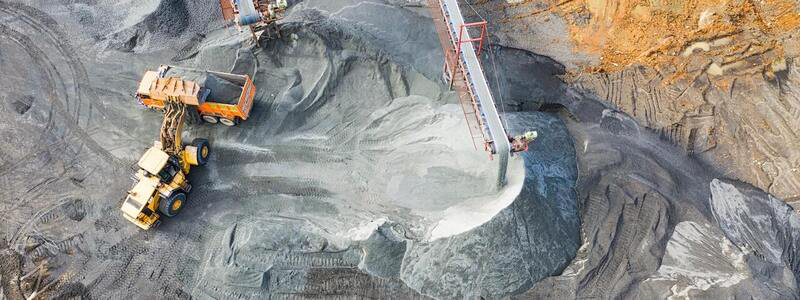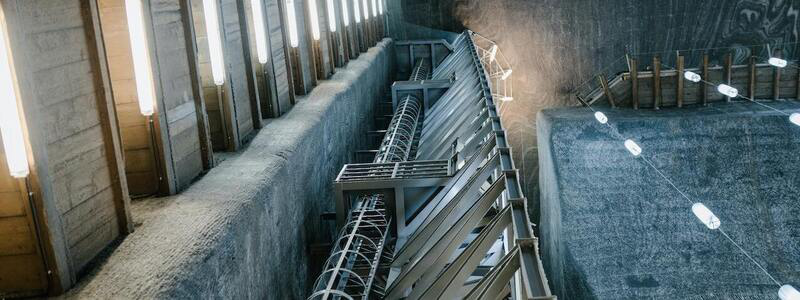Mining is one of the most vital components in today’s modern society due to the resources we stand to gain; in particular, surface mining makes up a massive percentage of mining projects. Surface mining is a process through which the soil and overlying rocks are removed to access the mineral deposits. It is mainly used to obtain sand, phosphates, crushed stone, copper, coal, aluminum, iron, and other metals. It may seem like a complicated process, but surface mining becomes an easy feat to accomplish through the use of proper equipment and proper training.
Two-thirds of the world’s solid minerals are obtained through surface mining. Surface mining has been around for thousands of years, and many different techniques have been developed to extract minerals from different depths.
American Mine Services is the top mining company in the US, providing the country with quality mining solutions since 1967. We have many years of experience handling the evaluation, design, and construction of mines. We also conduct excavations and tunnel constructions.
We have helped high-profile clients, such as the Department of Energy and The US Army Corps Of Engineers, complete various projects across the US. Our mining services include:
- Underground Development
- Contract Operations and Training
- Equipment and Facility Installation
- Mine Rehabilitation
- Mine Sealing
- Drill and Blast
- Rock Excavation
- Ground Support
- Tunneling
- Highwall Work

Surface Mining Techniques
Surface mining is mainly used to develop deposits of many minerals and coal seams. First, you must clear the vegetation and soil from the immediate surface.
The overburden (intermediate layer of sediment and rock) is then blasted, and heavy equipment such as earthmovers are used to remove it. Once the mineral is exposed, dragline excavators are used to extracting it.
However, the feasibility varies with the nature of the body ore. For instance, sizeable low-grade ore deposits are widely preferred as they allow for high resource recovery and provide enough space to place large mining equipment.
Here are the main types of surface mining:
Strip Mining
In this case, a thin layer of vegetation, soil, and rock lying above a mineral seam is removed using huge machines like bucket wheel excavators to access the desirable mineral deposits.
Strip mining is generally used when the mineral deposit is close to the surface. It is, however, impractical and damaging to the terrain if the ore is too far beneath the surface.
Depending on the surrounding terrain and amount of ore under the surface, two types of strip mining exist;
- Area stripping extracts minerals over large and flat terrains in long strips. The overburden of soil and rock is dropped in previous strips to prevent long gaps from being left in the earth once mining is complete.
- Contour mining is used when mineral seams follow the contours of hilly terrains and outcrops. The overlying landscape is carefully removed along the seam in more minor, custom-shaped excavations rather than long strips.
Open-pit Mining
Open-pit mining is similar to strip mining, except the pit from which the ore is removed is not refilled. Persians, Greeks, and Romans used this method to mine for salt, marble, and granite.
Open-pit mining is commonly used to extract building materials like limestone and marble. An open-pit mine produces a large amount of ore without the expensive process of removing overburden, as the ore is often close to the surface and spread over a large area.
The disadvantage of open-pit mining is that it is dangerous to work in and permanently damages the surrounding environment.
As mining progresses, the pit grows in size until there is no more ore to mine or the overburden becomes too great. Open holes are usually converted to landfills or waste disposal sites when mining becomes uneconomical.
Mountaintop Removal
Mountaintop removal mining is used to recover mass amounts of minerals like coal from mountain peaks.
The extraction process involves blasting overburden above the mineral seam with explosives to expose the ores. The broken mountain top is then moved to the fills and valleys below.
Mountaintop mining extracts ore 400 feet below the ground or deeper. There is controversy surrounding this method of the mining as permanent alteration of landscapes and ecosystems is experienced after the removal of mountain tops.
However, advocates point out that mountaintop mining leaves behind a flat terrain after reclamation is complete.
Dredging
Dredging is the process of recovering minerals from the bottom of water bodies like lakes, rivers, and oceans.
It is a more sophisticated version of panning for gold. The method is mainly used to mine gold.
Dredging uses barges fitted with conveyor belts and scoops moving up the water table. Scoops lift material onto a conveyor belt, where the mineral is removed onboard a barge.
Once the mineral has been retrieved, unwanted material is dropped back into the water using a different conveyor belt. Dredging, however, can cause downstream sedimentation and flooding if not done correctly.
High Wall Mining
Highwall mining is when machines collect minerals from unmined walls with overburden and exposed ores. It is a combination of surface and sub-surface mining.
High walls are usually found at the edge of pit mines and quarries. They enable miners to retrieve minerals from a wall that would be too expensive to clear of overburden before reaching the mineral.
High wall mining is also used in contour strip mines to recover additional ore from mineral seams above a created terrace.
A remotely controlled high wall machine uses continuous drilling to excavate from the face of the wall in a tight square. Pulleys and conveyor belts move collected minerals from the drill through the device, and all leftover matter is deposited behind the training.
Because high-wall miners are remote, they tend to be safer than underground mining. High-wall mining is also cheaper than other methods because it only requires a skeleton crew.

Why Choose Surface Mining?
Because it is more cost-effective to remove overburden to access minerals than tunneling underneath the earth’s surface.
Surface mining is safer and does not require extensive water piping, ventilation, or electricity rigging.
Common Surface Mining Equipment
Surface mining uses a diverse array of equipment. Mining is dangerous in its own right, but using the wrong equipment increases your chances of getting hurt.
If you wish to be involved in surface mining, it helps to know the names of the equipment you’ll use.
Some of the primary surface mining equipment includes;
- Backhoes
- Blasthole drills
- Feeders
- Wheel loaders
- Bins
- Bulldozers
- Fuel tanks
- Hoppers
- Shovels
- Classifiers
- Draglines
- Dredgers
- Generators
- Maintenance and repair shops
- Skid steers
- Front-end loaders
- Haul trucks
- Jaw Crushers
- Cone crushers
- Cranes
- In-pit conveyor systems
- Scrapers
Common Physical Characteristics Of Surface Mines
The characteristics of every surface mine vary depending on the mine’s location and the material being mined, but there are specific physical characteristics that cut across every mine.
Surface mines have a unique physical landscape, and specialized terms are used to describe the features found therein. These terms include:
- Berm
- Angle of repose
- Bench
- Highwall
- Haul road
- Pit
- Stockpile
- Settling pond/tank
- Wastepile
To be better prepared to participate in surface mining, it is best to know the meaning of these terms and how they can be used.

Commonly Used Equipment
Depending on whether the work is being carried out above or below ground, there are diverse sets of equipment frequently used to extract minerals in surface mining.
If you are planning on working at a surface mine, it is important to know the names of the machinery involved and how they are used.
Here are a few of the industry’s most common types of equipment:
- Backhoes
- Bins
- Cone crushers
- Dozers
- Dredges
- Draglines
- Feeders
- Fuel tanks
- Front-end loaders
- Generators
- Human transport
- Haul trucks
- Hoppers
- Jaw crushers
- In-pit conveyor systems
- Overland conveyor systems
- Maintenance and repair shops
- Scrapers
- Shovels
- Screw conveyors
- Track haulage
- Skid steers
- Truck scales
- Water reclamation systems
- Classifiers
- Cranes
What Do You Need The MSHA Safety Training?
If you plan to work at any surface mine, you must undergo specific safety training as directed by the Mining Safety and Health Administration (MSHA). This safety training requirement for most surface mines is called MSHA Part 46, aimed at reducing the risk of illness, injury, or death on the job.
Every mine operator is thus required to undergo these safety programs:
- Newly Hired Experienced Miner
- Site-Specific Hazard Training Program
- New Miner Training Program
- Annual Refresher Training Program
- New Task Training Program
Additionally, surface and underground mines that are not covered by MSHA Part 46 are covered by MSHA Part 48.
How Can We Help? American Mining Servicies
Our commitment to quality and safety ensures high satisfaction among both employees and clients, and customers consistently return to engage with us on additional projects. We have worked on the following projects:
AMS has over 50 years of experience in evaluating, designing, and constructing mines and tunnels for a variety of construction needs nationwide. Some projects that we’ve recently been awarded are the Crystal Creek dam improvement project and the Fort Dodge Wall structure solicitation. Contact us with any inquiries.
American Mine Services
130 Miners Drive
Lafayette, Colorado 80026


